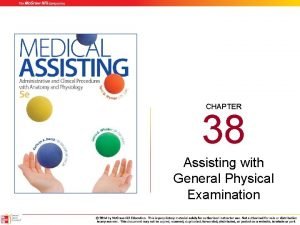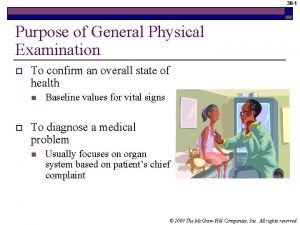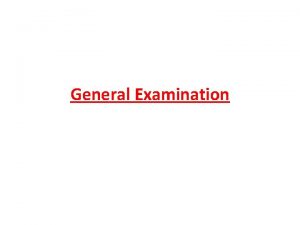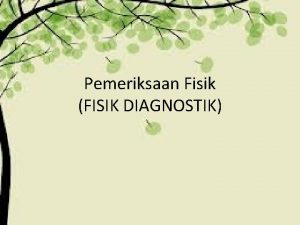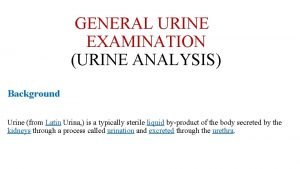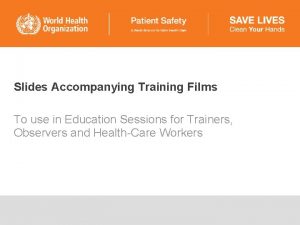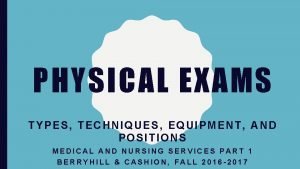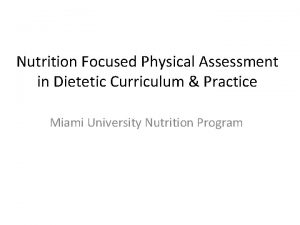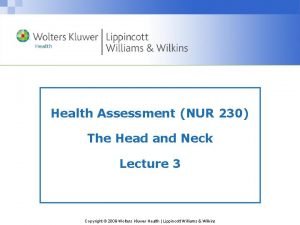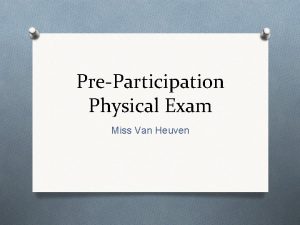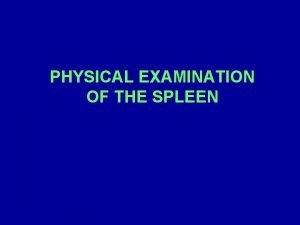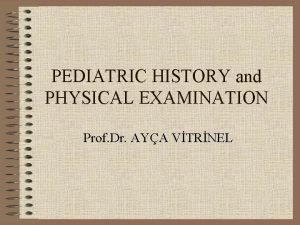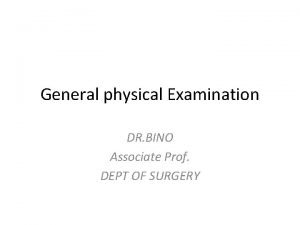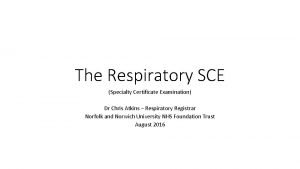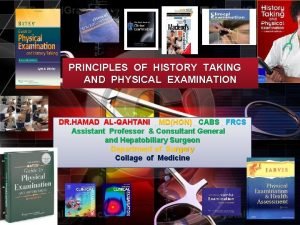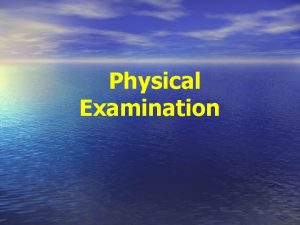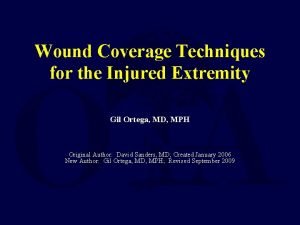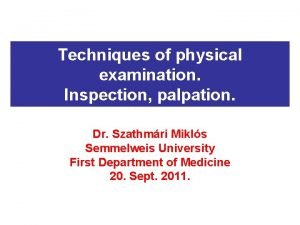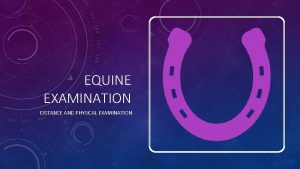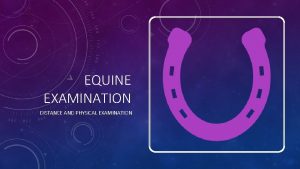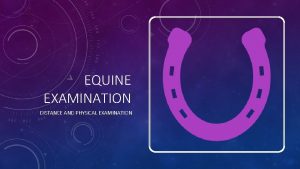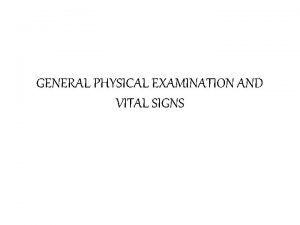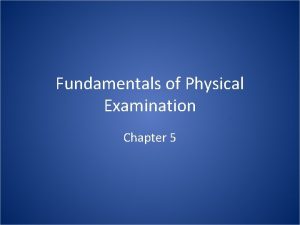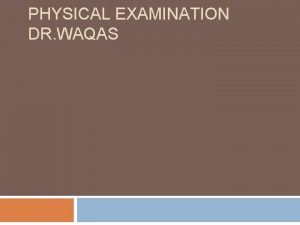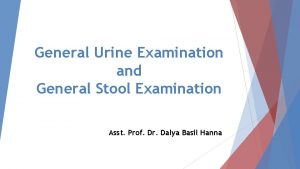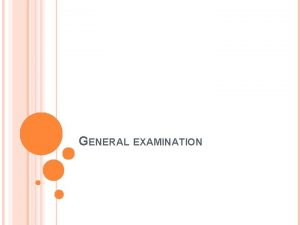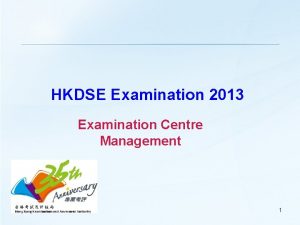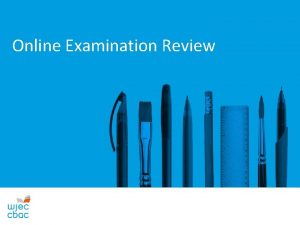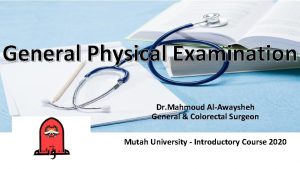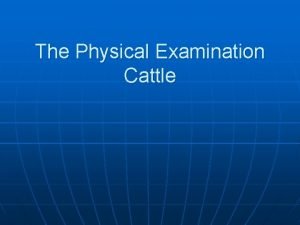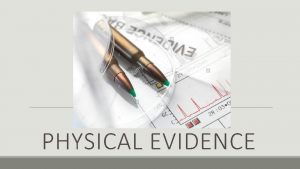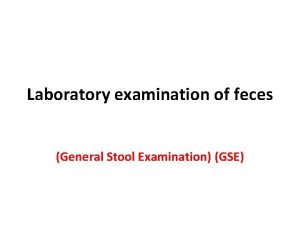38 1 Purpose of General Physical Examination o






















- Slides: 22

38 -1 Purpose of General Physical Examination o To confirm an overall state of health n o Baseline values for vital signs To diagnose a medical problem n Usually focuses on organ system based on patient’s chief complaint © 2009 The Mc. Graw-Hill Companies, Inc. All rights reserved

38 -2 Purpose of General Physical Examination (cont. ) o Clinical diagnosis n Based on signs and symptoms of a disease o o n Sign – objective information that can be detected Symptom – subjective information from the patient Laboratory and diagnostic tests o o Confirm clinical diagnosis Aid in forming differential diagnosis Aid in developing a prognosis Formulate a treatment plan and/or drug therapy © 2009 The Mc. Graw-Hill Companies, Inc. All rights reserved

38 -3 Preparing the Patient for an Examination o Emotional – explain exactly what will occur o Physical – offer the bathroom and instruct the patient on how to disrobe and don a exam gown o Positioning and draping – help patient assume needed exam position and drape to provide privacy © 2009 The Mc. Graw-Hill Companies, Inc. All rights reserved

38 -4 Preparing the Patient for an Examination: Positioning and Draping o Positions facilitate physician’s examination n Assist the patient to appropriate position n Make as comfortable as possible n Cover with appropriate drape o Keep patient warm o Maintain privacy / modesty © 2009 The Mc. Graw-Hill Companies, Inc. All rights reserved

38 -5 Preparing the Patient for an Examination: Positioning and Draping (cont. ) o Positions n n n n Sitting Supine / recumbent Dorsal recumbent Lithotomy Trendelenburg’s Fowler’s Prone n n n Sims’ Knee-chest Proctologic © 2009 The Mc. Graw-Hill Companies, Inc. All rights reserved

38 -6 Preparing the Patient for an Examination: Positioning and Draping (cont. ) o Sitting o Supine / Recumbent o Dorsal recumbent © 2009 The Mc. Graw-Hill Companies, Inc. All rights reserved

38 -7 Preparing the Patient for an Examination: Positioning and Draping (cont. ) o Lithotomy o Fowler’s o Trendelenburg’s o Prone © 2009 The Mc. Graw-Hill Companies, Inc. All rights reserved

38 -8 Preparing the Patient for an Examination: Positioning and Draping (cont. ) o Sims’ o Knee-Chest o Proctologic © 2009 The Mc. Graw-Hill Companies, Inc. All rights reserved

38 -9 Examination Methods o Inspection o Palpation n Visual examination n n Assesses posture, mannerisms, and hygiene Touch texture, temperature, shape n Size, shape, color, position, symmetry Presence of vibration or movements n Superficial or with additional pressure n n Presence of abnormalities © 2009 The Mc. Graw-Hill Companies, Inc. All rights reserved

38 -10 Examination Methods (cont. ) o Percussion n n Tapping and striking the body to hear sounds or feel vibrations Determine location, size, or density of structure or organ o Auscultation n Listening to body sounds n Assess sounds from heart, lungs, and abdominal organs © 2009 The Mc. Graw-Hill Companies, Inc. All rights reserved

38 -11 Examination Methods (cont. ) o Mensuration n Measuring n Height and weight n Length or diameter of extremity n Growth of uterus during pregnancy o Manipulation n Systemic moving of a patient’s body parts n Range of motion of joints © 2009 The Mc. Graw-Hill Companies, Inc. All rights reserved

38 -12 Components of the General Physical Examination o Overall appearance and the condition of skin, nails, and hair o The body n n Head, neck, eyes, ears, nose and sinuses, mouth, and throat Chest and lungs, heart, breasts Abdomen, genitalia, and rectum Musculoskeletal and neurological systems © 2009 The Mc. Graw-Hill Companies, Inc. All rights reserved

38 -13 Components of the General Physical Examination (cont. ) o General appearance o Head n Skin – a good indicator of overall health n Abnormal condition of scalp or skin n Nails and nail beds n Puffiness n Hair – pattern of growth and texture n Abnormal growths © 2009 The Mc. Graw-Hill Companies, Inc. All rights reserved

38 -14 Components of the General Physical Examination (cont. ) o Neck n n Lymph nodes, thyroid glands, and major blood vessels Symmetry and range of motion o Eyes n The presence of disease or abnormalities n Pupils for light response n Muscles n Internal structures © 2009 The Mc. Graw-Hill Companies, Inc. All rights reserved

38 -15 Components of the General Physical Examination (cont. ) o Ears n Outer ear o o n o Symmetry and size Presence of lesions, redness, or swelling Inner ear structures o o Canals Eardrums Nose and sinuses n Nasal mucosa n Structures of nose n Palpation to check for tenderness in sinuses © 2009 The Mc. Graw-Hill Companies, Inc. All rights reserved

38 -16 Components of the General Physical Examination (cont. ) o Mouth and throat n Mouth – impression of overall health and hygiene o Chest and lungs n Inspection o o o n Throat o o Common site of infection Tonsils – swelling or redness Symmetry in expansion Shape Posture position n Palpation – fluid or foreign mass in lungs n Auscultation – listen for abnormalities © 2009 The Mc. Graw-Hill Companies, Inc. All rights reserved

38 -17 Components of the General Physical Examination (cont. ) o Heart and vascular system n n Percussion – size of heart Auscultation o o n Heart sounds Rate, rhythm, intensity and pitch Pulses o Breasts n o Palpation for abnormalities Abdomen n n Inspection Auscultation Percussion Palpation © 2009 The Mc. Graw-Hill Companies, Inc. All rights reserved

38 -18 Components of the General Physical Examination (cont. ) o Musculoskeletal system n n n Posture Gait Range of motion Muscle strength Body measurements Development and coordination in children o Neurological system n n n Reflexes Mental and emotional status Sensory and motor functions Intellectual assessment in children Mental status and memory in elderly © 2009 The Mc. Graw-Hill Companies, Inc. All rights reserved

38 -19 Completing the Examination o Assist patient to a sitting position o Allow the patient to perform any necessary self-hygiene measures o Additional tests or procedures © 2009 The Mc. Graw-Hill Companies, Inc. All rights reserved

38 -20 Completing the Examination (cont. ) o Patient education n n Assess needs Topics o o o n n n Risk factors for disease Medication administration Self-help or diagnostic techniques Do not talk down to patient Ensure understanding Give written instructions © 2009 The Mc. Graw-Hill Companies, Inc. All rights reserved

38 -21 Completing the Examination (cont. ) o Special problems of the elderly n Greater need for patient education n Common problems: n o Incontinence o Depression o Lack of information on preventive medicines o Lack of compliance when taking medications Involve family members when possible © 2009 The Mc. Graw-Hill Companies, Inc. All rights reserved

38 -22 In Summary o General physical examination n n o Provides information about patient’s overall health status Assists the physician in making a diagnosis, prognosis, and treatment plan Medical assistant n n Addresses the comfort, privacy, and education needs of the patient Anticipates the needs of the physician during the examination © 2009 The Mc. Graw-Hill Companies, Inc. All rights reserved
 Chapter 38 assisting with a general physical examination
Chapter 38 assisting with a general physical examination General physical examination
General physical examination General appearance medical
General appearance medical General purpose specific purpose central idea
General purpose specific purpose central idea Loose thought process
Loose thought process Nnsdo
Nnsdo General examination
General examination General urine examination
General urine examination Physical examination tray
Physical examination tray Physical assessment types
Physical assessment types Nutrition focused physical examination
Nutrition focused physical examination Focused gi assessment
Focused gi assessment Bates guide to physical examination
Bates guide to physical examination Office-based pre-participation physical examination
Office-based pre-participation physical examination Percussion of spleen
Percussion of spleen Integumentary system assessment
Integumentary system assessment Sneezing
Sneezing Pitting edema stages
Pitting edema stages Respiratory sce
Respiratory sce Principles of history taking
Principles of history taking What is tactile fremitus
What is tactile fremitus Mathes nahai
Mathes nahai Palpation purpose
Palpation purpose
